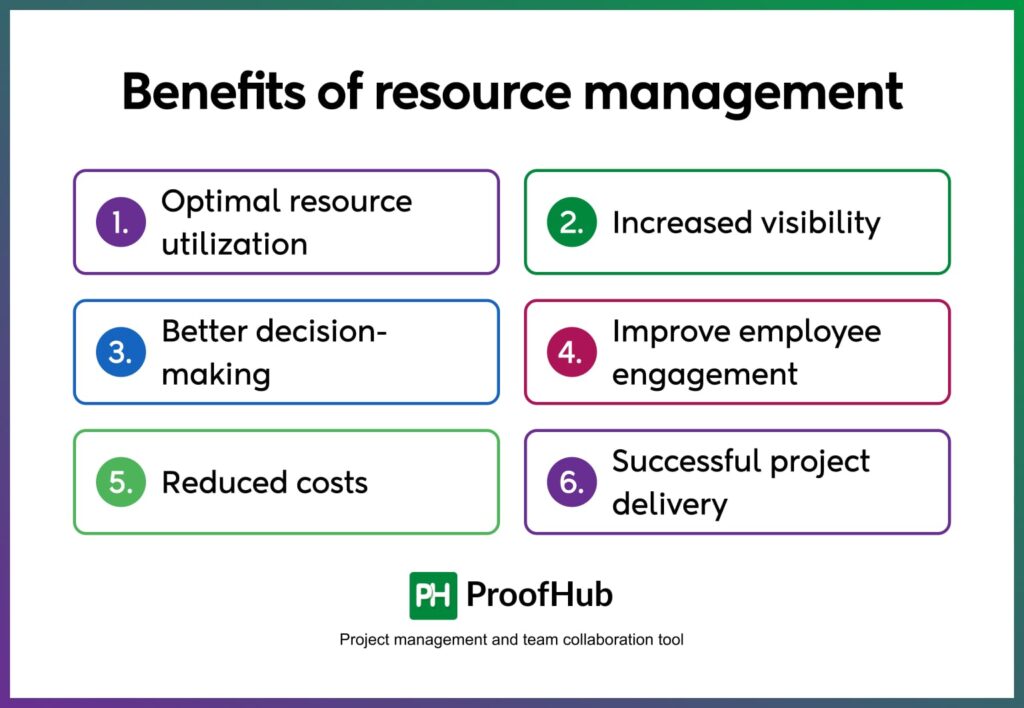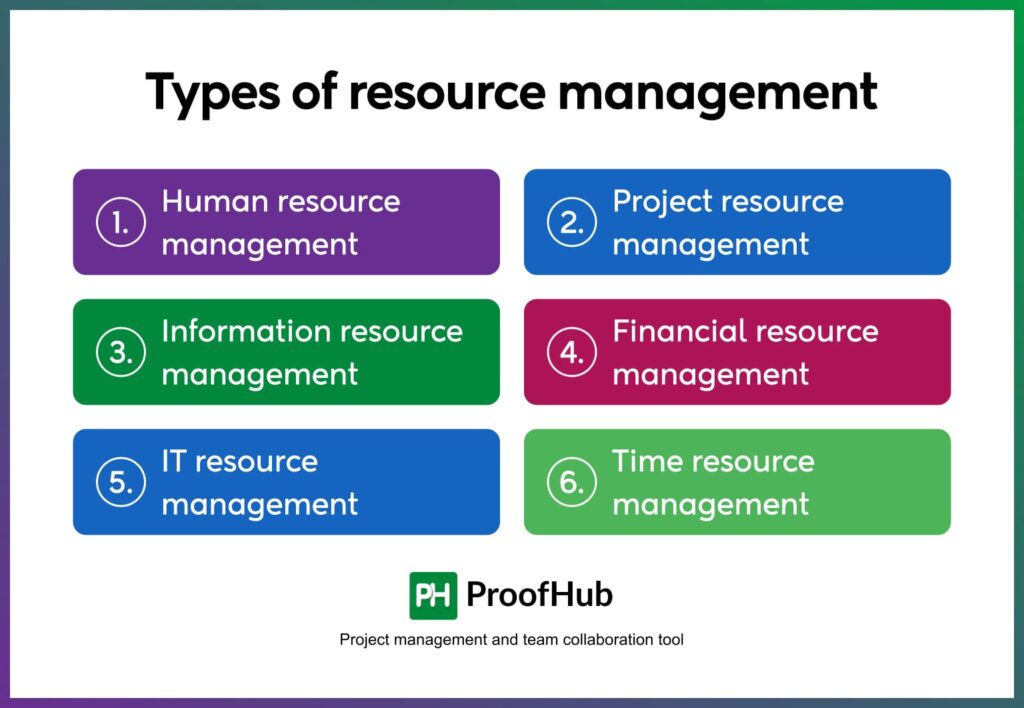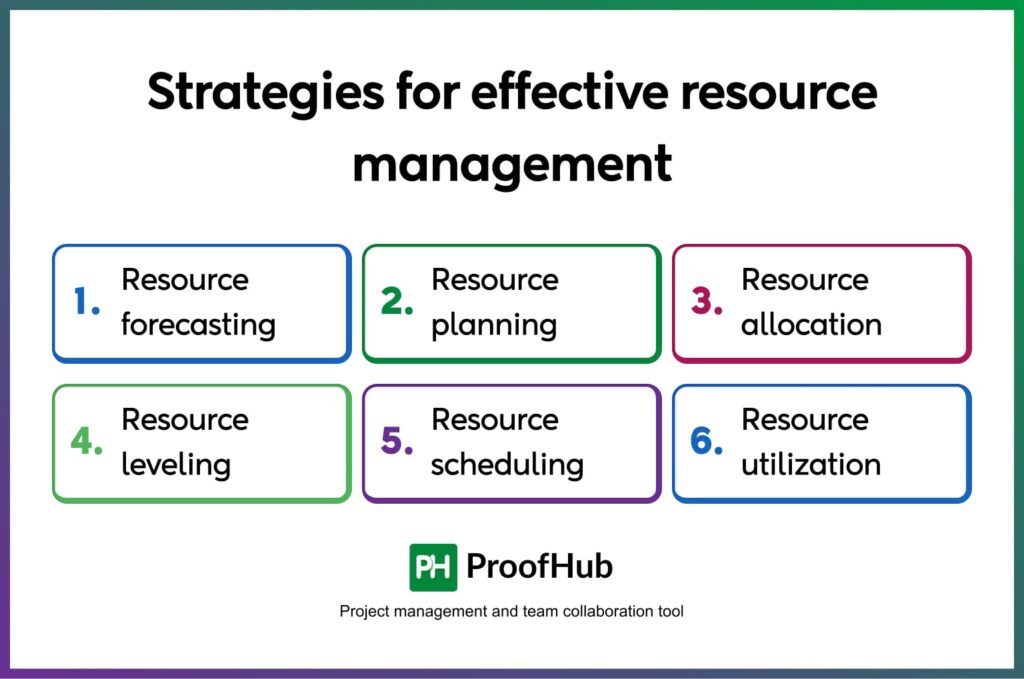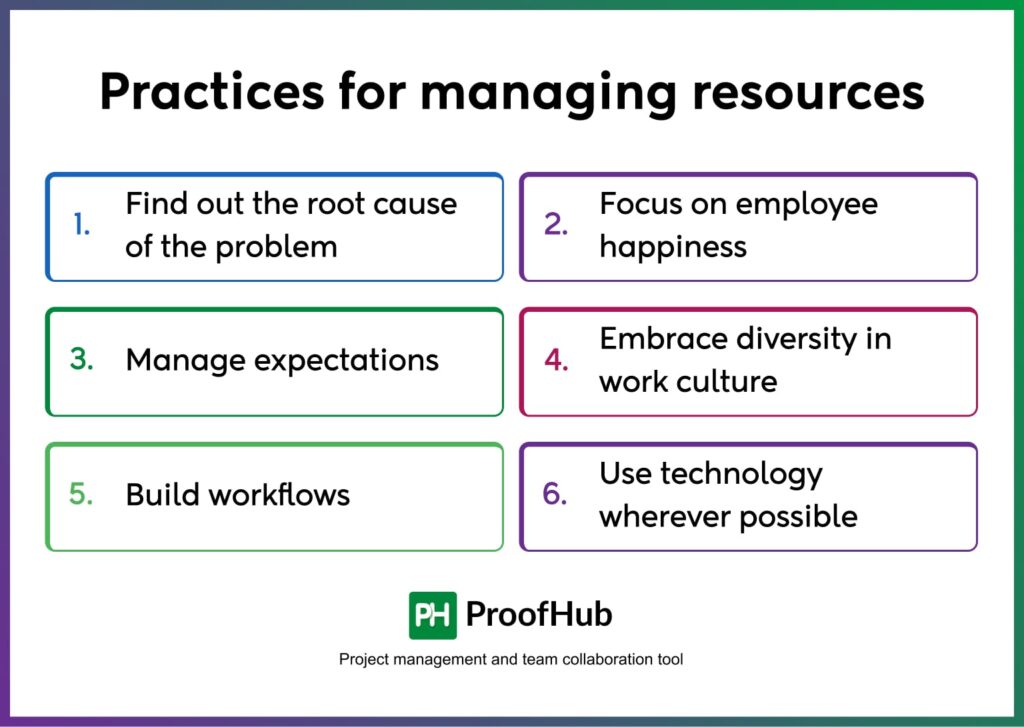Efficient resource management is not about hiring bulk and stockpiling non-human resources. Instead, it is about making the most of what you already have.
It is a practice of thoroughly evaluating and understanding your resource capacity, capabilities, and potential to maximize efficiency and achieve more significant organizational goals.
Be it people, money, hardware, technology, or time, every resource must be strategically optimized, as the strength of every organization lies in its resources.
In this post, we will look in-depth at resource management and all the related concepts that make it an integral parameter of determining business success.
A Free guide to help you with proven ways to lead a project from start to finish, without confusion or jargon.

Let’s get started.
What is resource management?
Resource management is the process of planning, forecasting, managing, scheduling, and monitoring resources to optimize project performance. The goal is to minimize time waste, cut operational costs, and maximize productivity for better outcomes.
It is critical for organizations that aim for sustainable growth. Effective resource management ensures that the right people are focused on initiatives that drive the most significant business outcomes. Organizations can effectively utilize these resources to speed project delivery without compromising quality and deadlines.
Why is resource management important?
Resource management is crucial to every organization, regardless of the industry and size. It provides significant advantages without requiring drastic changes to company culture and procedures.

Some of the key benefits of resource management are:
- Optimal resource utilization: With real-time insights into your team’s workload and capabilities, you can prevent resource overloading and do justice to their potential. Also, you can identify unused assets to redeploy them strategically for seamless task execution and maximum efficiency.
- Increased visibility: Resource management enhances resource capacity, availability, and utilization transparency. You can use these insights to identify potential constraints and risks early, allowing you to intervene in issues before they escalate.
- Better decision-making: Better insights into resource data prepare you for unforeseen challenges and enhance your control over project outcomes. You can proactively handle emerging issues and take corrective actions before they become major setbacks.
- Improve employee engagement: When you rightfully strategize resources into the tasks that go well with their skills and interests, they feel less burdened and frustrated. You can achieve better employee satisfaction and retention by considering their interests, capacity, and skills when allocating tasks.
- Reduced costs: Misallocating your team to the wrong tasks can strain your budget, such as unexpected expenses. By better understanding project requirements and resource capabilities, you can avoid cost overruns and boost productivity, ensuring getting the most value for your investments.
- Successful project delivery: The most significant benefit of resource management is the successful project completion within the defined time frame and budget. Effective management keeps everything on track and meets your project objectives.
What are the types of resource management?

Depending on the types of resources being managed, resource management can be divided into the following categories:
1. Human resource management
Human resource management focuses on managing human resources and talents. It involves everything from recruitment and onboarding to training, development, and performance management. The goal is to staff people in the right roles to succeed.
2. Project resource management
Project resource management concentrates on managing resources for successful project execution. This involves identifying the resource requirements of a project, planning efficiently for optimal resource allocation, and tracking resource utilization for better optimization.
Explore our comprehensive guide on project resource management to know more in detail
3. Information resource management
Information resource management deals with managing the entire organizational resource information. Some crucial aspects of IRM are knowledge management, data security and compliance, data governance, and record management to maintain information integrity.
4. Financial resource management
Financial resource management involves managing an organization’s monetary resources and economic activities. This includes financial analysis, planning, forecasting, budgeting, and reporting. Organizations can ensure long-term profitability and financial stability by mastering the above areas.
5. IT resource management
IT resource management prioritizes the effective utilization of IT systems and infrastructure. This involves managing hardware, software, and IT personnel. The activities performed are network management, asset management, software license management, and more.
6. Time resource management
Time resource management emphasizes making the best use of a valuable resource – time. It involves forecasting time requirements, scheduling tasks, tracking time, adjusting priorities, and utilizing time management techniques to support smooth operations and boost productivity.
What are the principles of resource management?
Here are some key principles of effective resource management that you must consider for optimal results:
1. Resource identification
Effective resource management starts with knowing all the resources available in your organization. Whether human, financial, hardware, or technological, you should be familiar with them for optimal performance. Also, you should be aware of each resource’s capabilities, inefficiencies, and limitations to bring the most out of their potential.
2. Human capital is the most important resource
Human resources isn’t a thing we do. It’s the thing that runs our business. – Steve Wynn
While each resource plays a significant role in the project’s success, human resources remain the most valuable. Technology and data can handle mundane tasks and highlight discrepancies more accurately and efficiently. However, only humans can bring creativity to the routine hustle and work on eliminating inefficiencies for better project outcomes.
3. A clear understanding of time estimates
A clear understanding of the time required to complete a task is crucial for effective resource management. This helps managers effectively plan resources, estimate task durations, and balance workload among team members without overburdening them beyond their capacity. Also, they can utilize these insights to evaluate progress and prioritize for optimal efficiency.
4. People management
As a manager, it’s your responsibility to set a clear vision of what you aim to achieve for your team. This ensures your team understands priorities, expectations, and responsibilities in achieving shared objectives. Additionally, you must always stay aware of team struggles and provide feedback and assistance as and when required for smooth project progression.
5. Resource allocation
Resource allocation isn’t a basic process of allocating resources to tasks in the to-do list. Instead, it is a thoughtful and strategic practice of understanding resource interests, abilities, and capacities before allocation. Also, assessing the specific project demands is essential to identify which resources can bring superior results. This ensures better results and optimizes resource use.
6. Appreciate and recognize
As crucial as it is to align the right resources to the right tasks, valuing their contributions and rewarding their achievements is equally important. When managers foster a culture of appreciation, employees become more engaged and motivated to work harder. This approach often results in a noticeable boost in morale, performance, and productivity, driven by a self-motivated workforce.
Strategies for effective resource management
Resource management strategies are the methods organizations use to measure and manage resources optimally for successful project execution. Despite the varied nature and approach, each strategy aims to maximize resource value, utility, and efficiency.

Here is a look at several resource management strategies:
1. Resource forecasting
Resource forecasting involves estimating and predicting the appropriate resources to complete a project. This proactive approach helps managers plan for future project requirements by uncovering potential gaps between resource ability and requirements for timely intervention. Managers must know the current resource capacity, project scope, and expected demand to forecast it better.
2. Resource planning
Resource planning is the basis of effective resource management. It considers resource capacity, availability, and skills to develop a plan that assures resource efficiency for current and future needs. This proactive approach ensures that resources are allocated effectively, minimizing potential disruptions and maximizing overall productivity.
3. Resource allocation
The process involves assigning resources to suitable projects or initiatives based on capacity, skills, and availability. The ultimate goal is to bring about the efficient utilization of available resources, avoiding both overburdening or underutilizing them. Visiting these insights helps managers plan better for the future to prevent delays and cost overruns.
Learn the practical resource allocation tips to maximize productivity and ensure success
4. Resource leveling
Resource leveling is re-assigning work to inefficiently used or underutilized resources within the organization. The aim is to maximize available resources by carefully evaluating their skills and abilities (additional to their current role) and identifying the areas they can contribute to optimally rather than increasing headcount unnecessarily.
5. Resource scheduling
Resource scheduling is a part of resource allocation; it consists of creating a project schedule that enlists all the tasks and resources required to complete them. Managers can develop clear timelines, identify available resources, and deploy them for the right tasks. This ensures the right resources are available at the right time and place, avoiding clashes.
6. Resource utilization
Having visibility into the utilization of resources across projects helps managers identify overutilized and underutilized resources. They can then adjust workloads, reallocate resources, and make other strategic adjustments to improve resource efficiency and productivity. The practice helps them balance resource demand and availability so that the workload seems manageable and not overwhelming.
What are the challenges of resource management?
Resource management may seem pretty straightforward to you at this stage. However, it has its own set of challenges. Here are some to consider.
- Poor resource capacity planning: Estimating resource requirements for projects isn’t as easy as it may sound. It’s not a task that can be relied upon guesswork or intuition. Instead, project managers should be meticulous to avoid mistakes that can cause significant setbacks, such as missed deadlines, compromised quality, and higher costs.
- Lacking resource utilization visibility: A project manager who doesn’t know where his team is spending time and lacks visibility into their capacity can never guarantee optimal resource allocation. According to 41% of professionals who state that visibility is essential in resource availability, that is a significant issue.
- Unclear project priorities: No matter how considerate managers are towards resource availability, capability, and skills, if they do not … project priorities when allocating tasks, everything is useless. They must ensure the tasks with major contributions to business objectives are appropriately resourced and prioritized.
- Setting unrealistic deadlines: Setting tight and unrealistic deadlines isn’t an ideal practice. It burns out your employees, causing them to work under pressure and rush out to provide results. The results contradict the expectations: compromised project quality, unmet quality standards, and delayed delivery.
- Inefficient time tracking: Not tracking your team’s time prevents you from accurately assessing productivity and utilizing your resources’ potential to the fullest. Also, with no clear insights into time spent on tasks, you can face discrepancies when billing your clients, leading to financial losses.
- Lack of dedicated resource management tool: Resource management is a multi-step process requiring you to constantly keep multiple balls in the air. Not having a comprehensive platform results in inefficient manual process handling, leading to inconsistent results and missed opportunities.
Read in detail, biggest challenges of resource management and their solutions to effectively overcome them
Best practices for managing resources
Effective resource management proves beneficial for maximizing team performance and increasing profits.

Here are some impactful practices to multiply business growth:
1. Find out the root cause of the problem
To begin with, find out the reasons that are stopping your organization from achieving efficient resource management. Is it improper planning, inaccurate resource estimation, conflicting priorities, or inefficient technology?
Only when you know the reason can you eventually figure out the best plan to mitigate the problem.
The best way to reach the root cause of the problem is by sitting with the team members and discussing things.
2. Focus on employee happiness
Employee happiness is the most overlooked yet crucial aspect of managing resources. Keeping your employees content to reduce turnover is essential, which can create a significant gap in your productivity metrics.
From balancing resource workload to aligning their skills and interests with tasks assigned – you should focus on their well-being. This will build their trust in you, and they won’t hesitate to go the extra mile to achieve your goals.
3. Manage expectations
There is nothing wrong with expecting timely delivery of tasks. But what brings chaos is when unrealistic expectations and demands emerge.
You evaluate task complexity and match it to the right skills, expertise, and experience. Set expectations realistically to avoid stressing out your employees. At the same time, make sure to communicate these expectations for effective planning and execution. This clarity is of utmost importance in managing your resources most efficiently.
4. Embrace diversity in work culture
Diverse mindsets and perspectives bring innovation and creativity to the workplace. Encourage a diverse workplace culture to make resource management efforts more effective and result-driven.
Every individual brings a unique skill set, which is the reason why you hire them. Therefore, it is crucial to be mindful of any unconscious biases and preferences. It can adversely affect their talent and confidence as well. Instead, make everyone feel inclusive and valued, regardless of the difference.
5. Build workflows
One of the easiest ways to clarify resource allocation and management is by embracing workflows. You can build custom workflows to define clear procedures and processes, ensuring everyone understands it comprehensively.
You can even take it a step further by automating these workflows, which 85% of leaders believe will allow their team to prioritize tasks that matter. The practice not only streamlines processes but also helps you identify the inefficiencies and bottlenecks that prevent you from achieving optimal excellence.
6. Use technology wherever possible
Utilizing resource management software helps eliminate common inefficiencies and challenges of resource allocation. These advanced solutions take the hassle out of manual handling of resource planning, allocation, and tracking.
You don’t have to chase down team members for task updates, but you can get real-time insights into resource utilization for better decision-making and strategic planning. This helps you manage resources across multiple projects and optimize your workflow without compromising quality or productivity.
Conclusion
Businesses run with the coordination of multiple resources, each contributing to its success uniquely. No matter how big or small your business is, investing in effective resource management is necessary for good results.
It is a continuous process that helps businesses optimize their resources for maximum output and smooth operations. Resource management software like ProofHub helps managers provide a comprehensive overview of resources distributed across tasks, time utilized for task completion, and identifying resource workload for maximizing potential and obtaining optimal results.
Want to streamline resource management practices for better efficiency? Start using ProofHub and discover the benefits yourself.
FAQs
What are the types of resources?
There are several types of resources in an organization. While some are quite common, others are less known to be considered as resources. These are:
- Human resources
- Financial resources
- Information resources
- Technological resources
- Physical resources
Which tools can help in resource management?
There are multiple tools available that can make resource management more efficient and seamless for managers. Some options to consider are:
- ProofHub
- Smartsheet
- nTask

